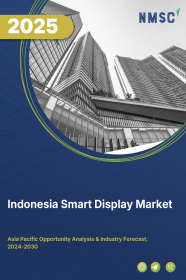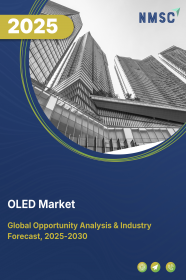
Indonesia Smart Display Market by Technology (LCD, LED, E-paper Displays, Oled, and Others), by Product Type (Standalone Smart Displays, Integrated Smart Displays (appliance-built), Interactive Touchscreen Displays, Transparent Smart Displays, and Others), by Display Size (Below 24 Inch, 24 Inch - 55 Inch, and Above 55 Inch), by Resolution, (Uhd (3840 × 2160), Fhd (1920 × 1080), Hd (1280 × 720 or 1366 × 768), and Others) and by Application– Opportunity Analysis and Industry Forecast, 2023–2030
Industry: Semiconductor & Electronics | Publish Date: 20-Sep-2025 | No of Pages: 151 | No. of Tables: 176 | No. of Figures: 121 | Format: PDF | Report Code : SE1031
Market Definition
Indonesia Smart Display Market was valued at USD 215.81 million in 2022, and is predicted to reach USD 1135.4 million by 2030, with a CAGR of 21.3% from 2023 to 2030. A smart display is a sophisticated device featuring a touchscreen or interactive visual interface, coupled with voice recognition and artificial intelligence capabilities.
Functioning as versatile information hubs, these displays can execute diverse tasks, including presenting information and managing smart home devices. They offer visual responses to voice commands, facilitating video calls and serving as interactive tools for scheduling, weather updates, and entertainment purposes.
Smart displays are meticulously crafted to elevate convenience, accessibility, and user engagement across various settings, such as homes, offices, and public spaces. Their applications span residential homes, offices, healthcare facilities, retail, education, and beyond.
Nationwide 5G Mid-band Deployment and Fibre Backbone Completion — Enabling Low-latency, Cloud-assisted Smart-display Experiences
Rapid expansion of Indonesia’s fixed and mobile broadband infrastructure — driven by the Palapa Ring fibre backbone and a focused push to allocate/roll out mid-band 5G spectrum — is materially lowering latency and improving throughput across urban and many peri-urban areas. That connectivity foundation makes always-on, high-quality smart-display features (HD video calling, cloud voice assistants, live streaming signage, AR/edge services) practical for consumers, retailers and public services; it also lets device makers design cheaper endpoint hardware by offloading compute and storage to cloud/edge platforms. As networks improve, commercial buyers (retail chains, hospitality, transit authorities) gain confidence in deploying interactive signage and analytics at scale, while households find value in persistent, connected home hubs that reliably support multimedia, telehealth and remote learning. Trackable near-term effects include faster rollout of telco bundles that include connected devices and growing interest from hyperscalers and telcos in local cloud/edge capacity.
National Industrial Policy, AI Roadmaps and Local Manufacturing Scale-up — Accelerating Localization, Affordability and Ecosystem Integration
Government programmes under the “Making Indonesia 4.0” agenda, recent Industry 4.0 expos and the new national AI roadmap are together strengthening local electronics design, testing and manufacturing capabilities. These policy signals (innovation centres, industry clusters, incentives for local assembly and AI/cloud investment) encourage OEMs to localize firmware, voice models, payment integrations and energy-optimised hardware for Indonesian use cases — reducing time-to-market for region-specific SKUs and lowering landed costs through larger local production runs and tighter supply-chain linkages. The result is more price-competitive smart displays, stronger after-sales support (local firmware updates, warranty service) and better partnerships with telcos, banks and public agencies for bundled offers and procurement. Over the medium term this increases household penetration and broadens commercial deployments across retail, hospitality, education and government digital services.
Regulatory & Data-protection Burden Slows Deployment
Tightening of Indonesia’s Personal Data Protection rules and Kominfo’s PSE registration requirements raise obligations for consent, local hosting and security. Vendors must add on-device/cloud safeguards, localise consent/firmware and—often—provision local storage or cross-border approvals, which increases engineering and legal costs and delays roll-out of cloud-dependent features. Smaller firms and startups are most affected, slowing broader market adoption.
Public-sector Smart-city, Transit & Telehealth Rollouts — A Pipeline of Procurements for Service-oriented Smart Displays
Indonesia’s “Gerakan Menuju 100 Smart City” masterplans and related municipal digitalization programs are creating repeatable public projects (interactive kiosks, transit information screens, civic-engagement hubs) that favour deployable smart displays with secure cloud/edge integration. At the same time, Ministry of Health telemedicine initiatives and authorized telehealth platforms are expanding demand for clinic- and community-level teleconsultation terminals and patient-information displays. Backed by national fibre builds (Palapa Ring) and expanding 5G, these public-sector programmes form predictable procurement channels and public–private partnership opportunities for vendors that can meet localization, security and service-level requirements — accelerating scale beyond pure consumer retail.
Competitive Landscape
The Indonesia smart display industry includes several market players such as Samsung Electronics Co., Ltd., LG Corporation, Sharp Corporation, Xiaomi Corporation, Lenovo Group Limited, Hisense Group Co., Ltd., PT Polytron Mega Buana, PT Vannoe Digital Indonesia, Sony Corporation, BenQ Corporation, Koninklijke Philips N.V., NEC Corporation, Panasonic Corporation, TCL Technology Group, PT Sentuh Digital Teknologi (Sentuh).
Key Benefits
-
The Indonesia smart display market report provides a quantitative analysis of the current market and estimations through 2023-2030 that assists in identifying the prevailing market opportunities to capitalize on.
-
The study comprises a deep dive analysis of the market trend including the current and future trends for depicting the prevalent investment pockets in the market.
-
The information related to key drivers, restraints, and opportunities and their impact on the market is provided in the report.
-
The competitive analysis of the market players along with their market share in the Indonesia smart display market.
-
The SWOT analysis and Porter’s Five Forces model are elaborated in the study.
-
Value chain analysis in the market study provides a clear picture of the stakeholders’ roles.
Indonesia Smart Display Market Key Segments
By Technology
-
Lcd
-
Led
-
E-paper Displays
-
Oled
-
Others
By Product Type
-
Standalone Smart Displays
-
Integrated Smart Displays (appliance-built)
-
Interactive Touchscreen Displays
-
Transparent Smart Displays
-
Other Display Types
By Display Size
-
Below 24 Inch
-
24 Inch - 55 Inch
-
Above 55 Inch
By Resolution
-
Uhd (3840 × 2160 Or Higher)
-
Fhd (1920 × 1080)
-
Hd (1280 × 720 Or 1366 × 768)
-
Other Resolutions (2k, Wxga, Custom)
By Application
-
Smart Home
-
Voice-controlled/assistant Smart Display
-
Smart Appliance Display (fridge, Oven, Hvac, Etc.)
-
Smart Display Mirror - Home
-
-
Automotive (smart Mirror)
-
Oem Rearview Display Mirror
-
Aftermarket Rearview Display Mirror
-
Side-view Display Mirror
-
-
Digital Signage
-
Retail & Hospitality Signage
-
Transportation Hubs & Public Places Signage
-
Sports & Entertainment Venue Signage
-
Other Signage Applications
-
-
Healthcare
-
Patient Monitoring And Telehealth Displays
-
Diagnostic / Imaging Workflow Displays
-
Digital Whiteboards For Medical Staff
-
-
Automotive (other In-vehicle Displays)
-
In-dashboard Infotainment Displays
-
Digital Instrument Clusters
-
-
Other Consumer / Industrial Applications
Key Players
-
Samsung Electronics Co., Ltd.
-
LG Corporation
-
Sharp Corporation
-
Xiaomi Corporation
-
Lenovo Group Limited
-
Hisense Group Co., Ltd.
-
PT Polytron Mega Buana
-
PT Vannoe Digital Indonesia
-
Sony Corporation
-
BenQ Corporation
-
Koninklijke Philips N.V.
-
NEC Corporation
-
Panasonic Corporation
-
TCL Technology Group
-
PT Sentuh Digital Teknologi (Sentuh)
Report Scope and Segmentation
|
Parameters |
Details |
|
Market Size in 2022 |
USD 215.81 Million |
|
Revenue Forecast in 2030 |
USD 1135.4 Million |
|
Growth Rate |
CAGR of 21.3% from 2023 to 2030 |
|
Analysis Period |
2022–2030 |
|
Base Year Considered |
2022 |
|
Forecast Period |
2023–2030 |
|
Market Size Estimation |
Million (USD) |
|
Growth Factors |
Nationwide 5G Mid-band Deployment and Fibre Backbone Completion — Enabling Low-latency, Cloud-assisted Smart-display Experiences. National Industrial Policy, AI Roadmaps and Local Manufacturing Scale-up — Accelerating Localization, Affordability and Ecosystem Integration. |
|
Companies Profiled |
15 |
|
Market Share |
Available for 10 companies |
|
Customization Scope |
Free customization (equivalent up to 80 working hours of analysts) after purchase. Addition or alteration to country, regional, and segment scope. |
|
Pricing and Purchase Options |
Avail customized purchase options to meet your exact research needs. |

















 Speak to Our Analyst
Speak to Our Analyst

























